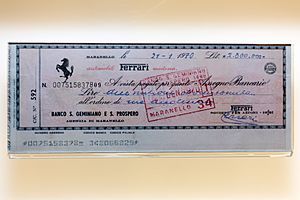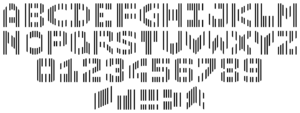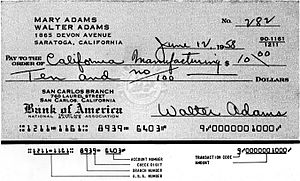Magnetic ink character recognition facts for kids
Magnetic Ink Character Recognition code, often called MICR code, is a special technology used mostly by banks. It helps them quickly and accurately process cheques and other important papers.
You can find the MICR code, also known as the MICR line, at the bottom of cheques. This line usually contains important details like the type of document, the bank code, the bank account number, the cheque number, and the amount of money (which is added later). Each country has its own way of formatting the bank code and account number.
MICR readers can scan this information directly into a computer system. Unlike barcodes, people can easily read MICR characters too. Documents with MICR codes can be processed much faster and more accurately than older methods.
Contents
Different MICR Fonts
There are two main types of MICR fonts (or styles of writing) used around the world: E-13B and CMC-7. Countries usually stick to one font, which works well because cheques don't often travel between different countries.
The E-13B font is used in many places, including Australia, Canada, the United Kingdom, the United States, Central America, and much of Asia. It's also an international standard.
The CMC-7 font is popular in Europe, like France and Italy, and in South America, including Argentina, Brazil, Chile, and Mexico. It's also an international standard.
Interestingly, Israel is the only country that uses both fonts at the same time. This makes their system less efficient, but it happened because Israelis chose CMC-7, while Palestinians chose E-13B.
E-13B Font
The E-13B font has 14 characters. These include the 10 numbers (0-9) and four special symbols:
- ⑆ (transit): Used to mark a bank code.
- ⑈ (on-us): Used to mark a customer's account number.
- ⑇ (amount): Used to mark the amount of money.
- ⑉ (dash): Used to separate parts of numbers, like in account numbers.
In the banking world, the E-13B MICR line is sometimes called the TOAD line. This name comes from the first letter of the four special characters: Transit, On-us, Amount, and Dash.
Sometimes, certain E-13B characters (like 2 and 5) can look a bit similar when scanned magnetically. But if magnetic reading fails, E-13B characters can also be read well by optical character recognition (OCR), which uses light to read characters.
CMC-7 Font
The CMC-7 font includes all 10 numbers, all 26 capital letters, and 5 special control characters.
CMC-7 characters look a bit like barcodes. Each character has unique gaps and patterns. This design helps prevent mistakes when reading them magnetically. However, if a magnetic scan doesn't work, these characters are harder to read with optical scanners because their bars are very close together.
How MICR Readers Work
MICR characters are printed on documents using special ink or toner that contains tiny magnetic particles, usually iron oxide.
When a document goes through a MICR reader, two things happen:
- The ink is magnetized.
- The characters are detected.
The characters are read by a special part called a MICR reader head. This is similar to the part that reads music from an old tape recorder. As each character passes over the head, it creates a unique electrical signal. The system can easily identify each character from this signal.
MICR readers are super important for sorting cheques. They are used at different stages in the cheque processing system. For example, a shop might use a MICR reader to sort cheques by bank before sending them to a central office. Then, the banks use MICR readers again to figure out which customer's account to charge and which branch the cheque belongs to.
Today, many banks don't send the physical cheques back to customers. Instead, they scan the cheques and store them digitally.
MICR in Unicode
The characters used in MICR and OCR have been added to the Unicode Standard. Unicode is a system that gives a unique number to every character in every language, so computers can understand and display them.
The special MICR E-13B characters are found in a part of Unicode called "Optical Character Recognition." These include:
- Error using : Input "2446" is not a hexadecimal value. (also known as "transit")
- Error using : Input "2447" is not a hexadecimal value. (also known as "amount")
- Error using : Input "2448" is not a hexadecimal value. (also known as "on us")
- Error using : Input "2449" is not a hexadecimal value. (also known as "dash")
The names for the last two characters were accidentally swapped when they were first named, but they still work correctly.
History of MICR
Before the mid-1940s, banks had to process cheques by hand. This was very slow and costly. As more and more cheques were used, banks looked for ways to automate the process.
In the mid-1950s, the Stanford Research Institute and General Electric Computer Laboratory created the first automated system to process cheques using MICR. They also developed the E-13B MICR font. The "E" meant it was the fifth font they considered, and "B" meant it was the second version. The "13" referred to the tiny 0.013-inch grid size of the characters.
The E-13B font was shown to the American Bankers Association (ABA) in 1956. The ABA officially adopted it in 1958 as the standard for cheques in the United States. They chose MICR because machines could read it very accurately, and it could be printed using existing technology. The first cheques with MICR were printed by the end of 1959. By 1963, almost all banks in the United States were using it.
Other countries also adopted MICR technology, often using equipment made in the US. The E-13B font became the standard in countries like Canada, the United Kingdom, and Australia.

The CMC-7 font was created in France in 1957. It became the MICR standard in Argentina, France, Italy, and some other European countries.
In the 1960s, MICR fonts became a symbol of modern technology. This led to the creation of other "computer" fonts that looked similar to MICR fonts, even though they weren't used for magnetic reading.
MICR E-13B is also used for other things besides cheques, like sales promotions, coupons, credit cards, and airline tickets.
See also
- Cheque truncation system
- Electronic Recording Machine, Accounting
- OCR-A
- OCR-B
- Amelia (typeface)
- Westminster (typeface)
 In Spanish: Reconocimiento de caracteres por tinta magnética para niños
In Spanish: Reconocimiento de caracteres por tinta magnética para niños



